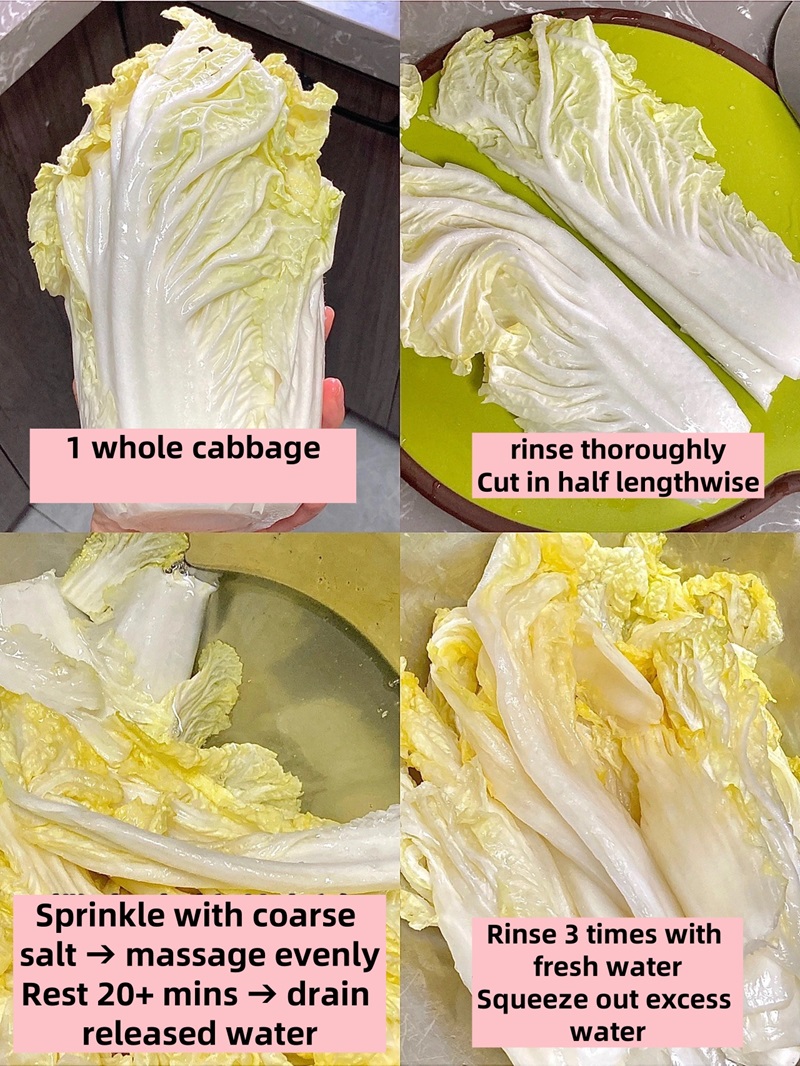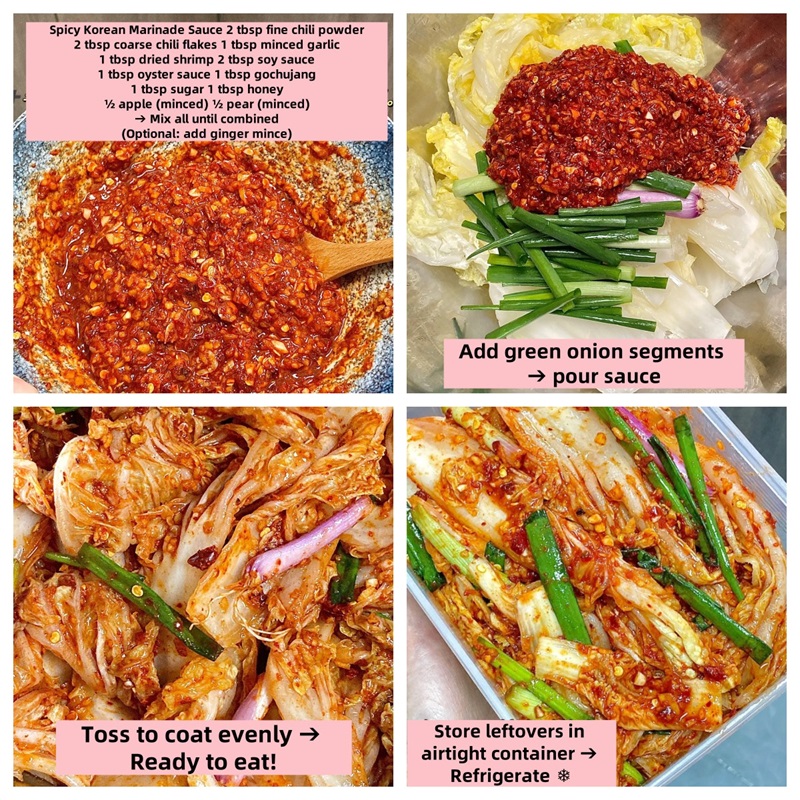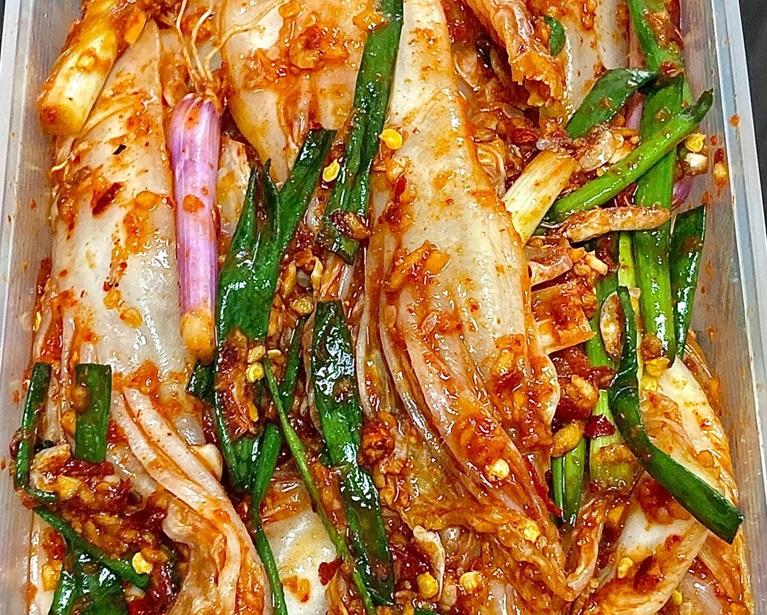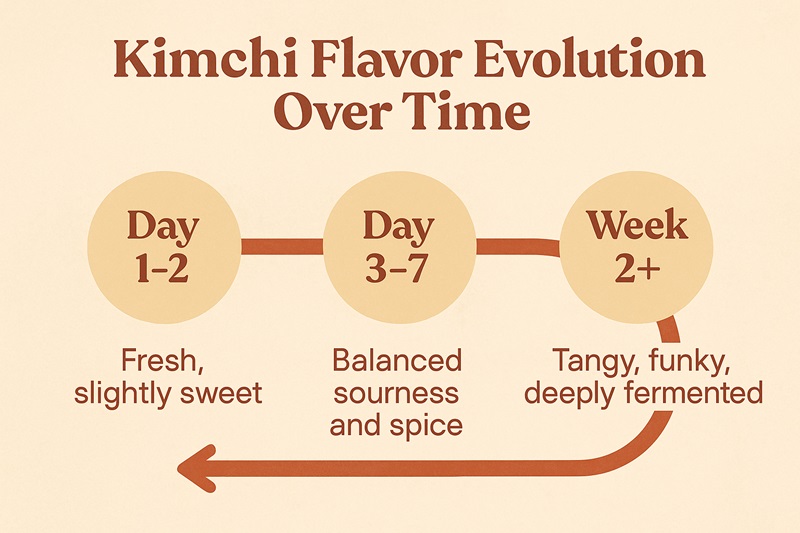Quick Answer: What Does Kimchi Taste Like?
Kimchi tastes tangy, spicy, salty, and a little sour, with a rich, deep flavor that feels bold and addictive.
Fresh kimchi is crisp and juicy, while older kimchi turns softer and stronger in taste.
The flavor changes with the ingredients, spice level, and how long it’s been fermented — from light and fresh to bold and funky.
What Exactly Is Kimchi?
Kimchi is Korea’s national dish — a traditional fermented side made from vegetables like napa cabbage or radish.
It’s mixed with Korean chili flakes (gochugaru), garlic, ginger, salt, and sometimes fish sauce or shrimp paste for extra flavor.
There are over 200 types of kimchi, but they all share one secret: fermentation.
This natural process turns simple vegetables into a probiotic-rich, tangy, and savory food that people all over the world love.
Breaking Down the Flavor of Kimchi
Tangy & Sour
Fermentation makes lactic acid, the same thing that gives yogurt and pickles their tangy taste.
Fresh kimchi tastes light and clean, while aged kimchi becomes sharper and more sour.
️ Spicy & Bold
The spice comes from gochugaru, Korean red chili flakes.
They bring a deep, smoky heat, not an intense burn.
Some kinds, like baek kimchi (“white kimchi”), skip the chili and taste mild and refreshing instead.
Umami & Savory
Fish sauce, anchovy paste, or kelp broth add umami, that “savory” taste found in foods like soy sauce or cheese.
This is what makes kimchi feel rich and hearty, even though it’s made from vegetables.
Crunchy & Juicy Texture
Kimchi’s texture is part of its magic.
Each bite is crisp, juicy, and full of flavor.
That crunch pairs perfectly with warm rice, noodles, or grilled meats, balancing soft and spicy textures in one bite.
Why Do People Love Kimchi?
1. A Flavor Explosion Like No Other
Kimchi’s magic lies in its balance: spicy, sour, salty, and umami all at once.
Each bite feels alive — complex, bold, and always changing as the fermentation continues.
2. Health Benefits in Every Bite
- Naturally probiotic, promoting gut health.
- High in vitamins A, B, and C.
- Low-calorie, yet deeply satisfying.
- Linked to improved digestion and immune support.
3. A Deep Cultural Connection
For many Koreans, kimchi isn’t just food — it’s heritage and memory.
Families often make it together during “kimjang”, the communal winter kimchi-making season, turning cooking into a celebration of tradition and togetherness.
How Kimchi’s Taste Changes Over Time
| Fermentation Stage | Taste Profile | Texture | Best Use |
| Fresh (0–2 days) | Mild, slightly salty, faintly sweet | Very crisp | Side dish with rice |
| Mid-fermented (3–7 days) | Balanced tang and spice | Crunchy but softening | All-purpose — pairs with any meal |
| Aged (2+ weeks) | Strongly sour, funky aroma | Softer, chewy | Cooking (stews, fried rice, pancakes) |
Tip: To truly understand kimchi’s complexity, taste it at each stage — you’ll discover a new version of the same dish.
The Story and Science of Kimchi — History, Process, and Evolving Flavor
Kimchi’s story stretches back over 3,000 years, long before chili peppers even reached Korea. Early versions were simple salt-preserved vegetables — a way to survive harsh winters without refrigeration.
When chili peppers arrived from the Americas in the 16th century, they transformed kimchi forever, adding color, heat, and the signature kick we know today.
The process remains surprisingly faithful to its roots. Vegetables are salted to remove moisture, then mixed with a seasoning paste of chili flakes, garlic, ginger, and fish sauce. Fermentation follows, powered by naturally occurring lactic acid bacteria that create the tangy acidity and gentle funk unique to kimchi.
What makes kimchi fascinating is how its flavor evolves over time and geography.
- In northern Korea, cooler climates inspired milder, less spicy versions with lighter seasoning.
- In the south, warmer weather and access to seafood led to bolder, saltier, and more complex styles.
Even within a single household, taste shifts — fresh kimchi bursts with crisp sweetness, while aged kimchi deepens into sharp, savory intensity.
Across regions and generations, this evolution reflects Korea’s adaptability — each batch telling a story of place, climate, and patience.


Different Types of Kimchi and Their Taste
1. Baechu Kimchi (Napa Cabbage Kimchi)
The most common kimchi, made from napa cabbage, chili flakes (gochugaru), garlic, ginger, and fish sauce.
Flavor: Spicy, tangy, and rich in umami.
Texture: Crunchy outer leaves with tender insides.
Pairs well with: Steamed rice or Korean BBQ.
2. Kkakdugi (Cubed Radish Kimchi)
Made from Korean white radish (mu) cut into cubes and fermented with chili, garlic, and salt.
Flavor: Peppery, slightly sweet, and refreshing.
Texture: Crisp and juicy.
Best served with: Hearty soups like seolleongtang or galbitang.
3. Oi Sobagi (Cucumber Kimchi)
A summer favorite made with stuffed cucumbers filled with chili, garlic, and vegetables.
Flavor: Light, crisp, and mildly spicy.
Texture: Crunchy and hydrating.
Tip: Best eaten fresh or after 1–2 days of fermentation.
4. Baek Kimchi (White Kimchi)
A no-chili version for those who prefer mild flavors.
Flavor: Tangy, sweet, and slightly aromatic from Asian pear and jujube.
Texture: Soft and light.
Fun fact: It’s often served to children or spice-sensitive eaters.
5. Bossam Kimchi (Wrapped Kimchi)
A luxury-style kimchi made by wrapping fillings (nuts, fruits, seafood) in large cabbage leaves.
Flavor: Complex — sweet, tangy, nutty, and aromatic.
Texture: Soft and layered.
Traditionally served during: Weddings or holidays.
6. Chonggak Kimchi (Ponytail Radish Kimchi)
Made from young radishes with their greens attached, named for their “ponytail” look.
Flavor: Sharp, peppery, and earthy.
Texture: Crunchy roots with slightly chewy leaves.
Commonly enjoyed with: Rice porridge or grilled fish.
7. Gat Kimchi (Mustard Leaf Kimchi)
Prepared from mustard greens, giving it a distinct pungent aroma.
Flavor: Peppery, bitter-sweet, and robust.
Texture: Soft leaves with spicy seasoning.
Pairs well with: Fatty meats or rich stews.
8. Nabak Kimchi (Water Kimchi)
A watery, pinkish kimchi made from thinly sliced radish and cabbage in a seasoned brine.
Flavor: Mild, tangy, and refreshing — less spicy than classic versions.
Texture: Crisp vegetables in a cool broth.
Ideal for: Pairing with noodles or fried dishes.
9. Dongchimi (Winter Water Kimchi)
A non-spicy, clear water kimchi made from radish, garlic, and pear — fermented during winter.
Flavor: Cool, clean, and subtly sweet.
Texture: Soft radish and light brine.
Fun fact: Often served cold as a palate cleanser between heavy dishes.
10. Yeolmu Kimchi (Young Summer Radish Kimchi)
Made from young radish greens harvested in early summer.
Flavor: Fresh, zesty, and slightly grassy.
Texture: Tender stems with slight crunch.
Great with: Cold noodles (naengmyeon).
How to Enjoy Kimchi (If You’re Trying It for the First Time)
Tasting kimchi for the first time can be exciting and surprising. Its bright red color, bold smell, and sharp flavor tell you right away — this isn’t a regular side dish. It’s a living food, still changing as it ferments each day. But how you take that first bite can make a big difference.
Start Simple
If you’re new to fermented foods or not sure about spice, begin with baek kimchi (white kimchi). It skips the chili flakes, so you can enjoy the crunch and gentle sourness without heat.
You can also try lightly fermented napa cabbage kimchi. It’s mild, crisp, and a bit sweet before the stronger flavor develops.
Find Balance
Kimchi tastes best with simple foods. Try a spoonful with warm rice, a soft fried egg, or noodles. These calm flavors balance the spice and bring out kimchi’s bright tang.
That’s why Korean families don’t treat kimchi as a sauce — they treat it as a must-have flavor on the table.
Try Cooking with It
Once you’re used to the taste, try adding kimchi to cooked dishes. Heat softens its sharpness and gives it a smoky, rich flavor.
Popular dishes like kimchi fried rice (bokkeumbap), kimchi pancakes (jeon), or kimchi stew (jjigae) show how versatile it is. Even a small bit of aged kimchi can add bold flavor to soups, stir-fries, or meats.
Don’t Fear the Smell
That strong scent isn’t a bad thing — it’s a sign of life. The same process that makes sourdough rise or cheese ripen gives kimchi its special aroma.
Once you taste past the first whiff, you’ll see why people around the world love it — that funk means flavor.
Be Curious, Not Cautious
Approach kimchi with an open mind. Like coffee or wine, its flavor grows on you.
Over time, you won’t just get used to it — you’ll start craving it.
Popular Kimchi Brands in the U.S. (Price, Taste, and Tips for Buyers)
As Korean food continues its global rise, kimchi has become a supermarket staple. Whether you’re exploring for the first time or hunting for an authentic taste, here are some trusted names and insights to guide your purchase.
1. Chongga Kimchi (Daesang)
- Flavor: Classic and bold with balanced spice and acidity.
- Best for: Those seeking authentic Korean-restaurant flavor.
- Price: Around $6–$9 per 16-oz jar.
- Where to find: H Mart, Amazon, and major Asian grocery stores.
2. Bibigo (CJ Foods)
- Flavor: Mildly spicy, clean taste with crisp texture.
- Best for: Beginners or those who prefer a lighter funk.
- Price: $5–$8 per 14-oz pouch.
- Tip: Excellent for kimchi fried rice or fusion recipes.
3. Mother-in-Law’s Kimchi (U.S. artisanal brand)
- Flavor: Small-batch fermented with natural probiotics; deep, tangy complexity.
- Best for: Health-focused consumers or kimchi enthusiasts.
- Price: $9–$12 per 16-oz jar.
- Note: Often found at Whole Foods or specialty stores.
4. Wildbrine
- Flavor: Vegan, non-fish-sauce recipe; bright and zesty with subtle chili.
- Best for: Plant-based eaters and those new to fermented foods.
- Price: $7–$10 per jar.
- Extra: Certified organic and probiotic-rich.
5. Mama O’s Premium Kimchi
- Flavor: Bold, garlicky, and slow-fermented for full flavor.
- Best for: People who enjoy stronger, more traditional funk.
- Price: $10–$14 per jar.
- Fun fact: Handcrafted in Brooklyn; favored by chefs and foodies.
Buyer’s Tips for Kimchi Seekers
- Check the label: Authentic kimchi lists napa cabbage, radish, chili flakes, garlic, and salt early in the ingredient list.
- Look for live cultures: Phrases like “naturally fermented” or “contains live probiotics” indicate active bacteria.
- Mind the storage: Keep it refrigerated, and remember — kimchi continues to ferment even after opening, meaning the flavor deepens over time.
- Start small: If you’re unsure, try single-serve packs before committing to larger jars.
Common FAQs
Is kimchi really spicy?
Not always! The spice level depends on the chili used. White kimchi isn’t spicy at all.
Does kimchi taste like pickles or sauerkraut?
They share a tangy base, but kimchi is bolder, more complex, and often garlicky with a warm chili depth.
Can you eat kimchi if you don’t like spicy food?
Yes — choose milder varieties or rinse spicy kimchi lightly before eating.
Why does kimchi smell strong?
It’s a natural part of fermentation — that aroma signals healthy bacterial activity, not spoilage.
Final Thoughts
Kimchi’s taste is alive — tangy, spicy, funky, and utterly satisfying.
It’s one of those rare foods that awakens every sense, from crunch to aroma. Whether you eat it fresh, aged, or cooked into comfort dishes, kimchi delivers a balance of flavor and culture that keeps people coming back for more.
So the next time you ask, “What does kimchi taste like?”, remember:
It tastes like tradition, time, and a little bit of magic in every bite.






